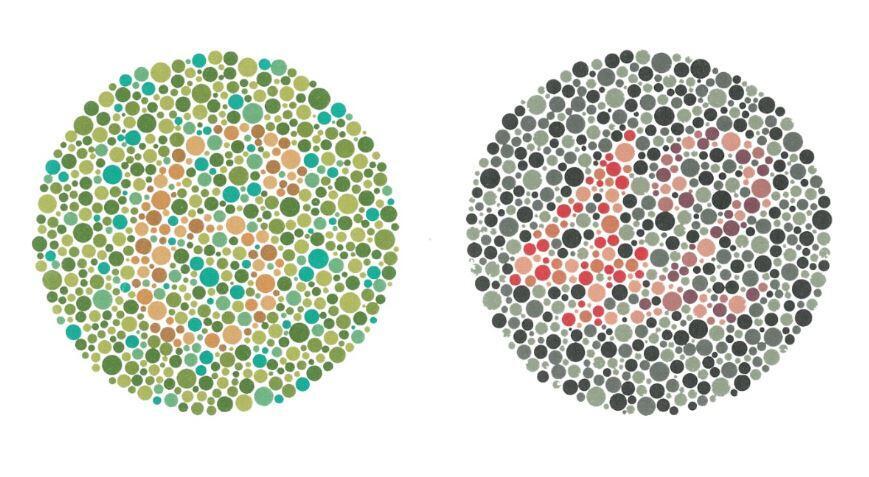Our world is teeming with visual stimuli - colors, patterns, and more. Our ability to perceive the world in colors undoubtedly enriches the way we experience reality. However, the way we perceive colors depends on the processing and interpretation of different light waves by our visual system . As we delve into this subject, we’ll discover that not everyone perceives colors in the same manner.
Read more:
Light is a form of electromagnetic radiation with particular physical properties, such as wavelength. What we call “color” is actually the way our sensory perception interprets the wavelength of the light, rather than an objective quantitatively measurable trait. The human eye can detect light at wavelengths from 400 nanometers (0.4 thousandths of a millimeter), which we consider as purple color, up to 700 nanometers, which we consider as red color. Therefore, the 400–700 nanometer range is referred to as visible light.
2 View gallery


The same image as seen by individuals with normal vision or with those that have a fewer number of functional cones
(Photo: Wikipedia, Q-lieb-in)
The retina contains three distinct types of light-absorbing, known as cones, each sensitive to light within a specific wavelength range - red, blue, and green. The combination of the three enables our brain to receive a multitude of response patterns and translate them into a broad range of different shades that we are able to perceive - about 10 million. Their distribution is such that 64% of the cones absorb wavelengths in the red range, 32% absorb green wavelengths, and only 2% of cones absorb wavelengths in the blue range. Differences in the number or characteristics of these cone types, such as the absence of one or more types of cones or the presence of a fourth cone type, can alter our perception of color.
Color Blindness
A complete absence of cones in the retina leads to total color blindness, known as achromatopsia, where an individual perceives the world solely in shades of gray. This condition is rare, occurring in approximately one out of every 40 thousand live births.
Partial color blindness is much more prevalent, affecting roughly 1–2 out of every twenty men. Its prevalence is considerably lower among women because the genetic defect that causes color blindness is located on the X chromosome. In females, the presence of a healthy gene on their second X chromosome can compensate for the defective copy. Men have only one X chromosome and thus a single defective gene copy is sufficient to result in color blindness.
The most common type of partial color blindness is red-green, where one cannot distinguish between the two colors. The predominant cause, affecting 6% of men, is a mutation in the green cone cell that shifts its sensitivity to longer wavelengths, making it more sensitive to red. Individuals with this mutation will also perceive dark green as black and will have difficulty distinguishing between different shades of red, orange, yellow, and green (long wavelengths). They can, however, easily identify lighter shades. Less common reasons for red-green color blindness are mutations or deficiencies in the red or the green cone cells. Blue-yellow color blindness also exists, but is much rarer in comparison.
The most common method for diagnosing color blindness is the Ishihara test. This test presents subjects with pictures of numbers in a certain color against a contrasting colored background, and they are asked to identify the colors they see. The test includes a range of images in different colors, allowing the determination of the specific type of color blindness a person has. For young children, who have yet to learn to read and write, objects (such as a car) are presented instead of numbers .
Despite their inability to distinguish between red and green, individuals with color blindness are permitted to drive since they can identify the positional arrangement of colors in traffic lights, with red positioned on top and green at the bottom.
Tetrachromacy (Four-Color Vision)
The contrasting and a much rarer phenomenon, is the presence of an additional, fourth type or cone cell in the retina of an individual, which provides the ability to perceive an even broader spectrum of colors. A study found that the emergence of the additional cone cell is due to mutations in the genes responsible for creating the pigments produced by the cones, which make them sensitive to different wavelengths.
2 View gallery


Anyone who is not color blind will see the number 6 on the left and the number 42 on the right. The Ishihara test
(Photo: Wikipedia Commons)
This situation is in fact the mirror image of color blindness, not only in the way it affects vision, but also due to the fact that it only affects women—in contrast to color blindness which is uncommon in women. The reason for this is that the genes for the red and green cones are located on the X chromosome, while the gene for the blue cones is located on a different chromosome. Occasionally, a mutation in the gene for red cones appears, altering the wavelength sensitivity. Since women have two X chromosomes, one of which is randomly silenced in each cell, cells in the retina could have a regular red cone, a mutated red cone, or a green cone (only one of them can be present in each cell). Together with the blue cone, this results in a total of four distinct types of cones in the retina.
However, it remains unclear how the retinal nerve cells would respond to the presence of another color channel—whether they would process it separately or integrate its signals with one of the other three color channels. A 2010 study proved that a woman with an extra cone perceived more colors than average individuals. For instance, she was able to distinguish between two slightly different mixtures of blue and yellow that looked identical to others. Nevertheless, she was the only one among 24 participants with an extra cone who exhibited tetrachromatic vision. This finding suggests that the mere presence of this cone is not a sufficient condition for perceiving more shades, since the visual system doesn’t always process the information coming from this extra cone separately.
Thus, it appears that we don’t all perceive colors in the same way. This teaches us that color perception is intrinsically a subjective matter, rooted in diverse information processing by our visual system and our brain. And this is even before considering the cultural differences in color definition. Yes, even when the physical properties of the light reaching our eyes, such as wavelength and intensity, remain identical.
Written by Dr. Iddo Magen of the Weizmann Institute of Science

